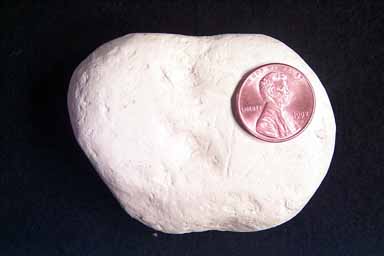igneous rocks
metamorphic
rocks
sedimentary rocks
|

Composition:
A biochemical rock composed of the microscopic tests (skeletons) of single celled organisms belonging to the phylum Haptophyta; common name coccoliths or coccolithophorids. Although we provide a close-up of this rock there is nothing more to see than in the larger image. Haptophyte skeletal elements can only be seen with a scanning electron microscope.
Description:
Soft, white, powdery, gritty rock that easily rubs off on you fingers. Reacts with dilute HCl producing large, foaming bubbles.
May be confused with kaoliniteor alabaster gypsum. Neither of these, however, react with acid.
Tectonic Association:
Because of its pelagic origins chalk does not form in places most other carbonates form. Today it is most abundant in the shallow portions of the oceanic rift systems (oceanic rises;Divergent Plate boundaries) and thus although extremely common relative to other carbonates, virtually never seen.
During the Cretaceous, however, sea level was at a very high level, and much of the continental masses were under water. This was also the time coccolith and similar pelagic organisms were becoming very abundant. As a result, Cretaceous chalk deposits are common. The are well known in the White Cliffs of Dover in England, and in the Paris Basin. North America also has vast areas of chalk deposits from the Cretaceous, mostly in the southern states and up through the Mississippi river valley, which was under water at the time.
The Haptophyte organisms that produce the coccolith skeletons that become chalk are pelagic organisms living in the surface waters of the world's oceans. The skeletons eventually settle to the bottom and accumulate to become chalk - if conditions are favorable.
Coccolith skeletons are settling most everywhere out of today's oceans, and should be accumulating everywhere in the oceans. But, if the water is too deep it becomes too cold, and the skeletons dissolve. Therefore, chalk accumulates only at shallower depths, and today that is along the oceanic rift systems (Divergent Plate Boundaries).
We might also expect chalk to accumulate in shallow waters next to continents, such as on the continental shelves, but here there is too much clastic sediment, and whatever skeletons get to the bottom are typically lost in the clays, silts, and sands.
Composition:
A biochemical rock composed of the microscopic tests (skeletons) of single celled organisms belonging to the phylum Haptophyta; common name coccoliths or coccolithophorids
Description:
In this close-up we see no more than in the full specimen. Even under a laboratory microscope we would not see much more. It takes a scanning electron microscope to see the coccolith skeletons.
Soft, white, powdery, gritty rock that easily rubs off on you fingers. Reacts with dilute HCl producing large, foaming bubbles.
|